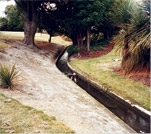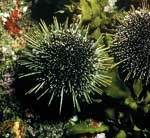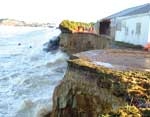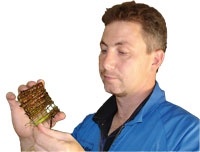PDF of this article (132 KB)



Ocean acidification workshop
Since the Industrial Revolution, the world’s oceans have absorbed more than a third of the carbon dioxide released into the atmosphere by man. This has reduced the buildup in the atmosphere, and so decreased the rate at which climate change is occurring. However, a side effect of this uptake is a slow increase in the acidity of surface waters. This acidification may have significant effects, both direct and indirect, on the biology and chemistry of the coast and oceans.
In May, NIWA, the Royal Society of New Zealand, and the University of Otago co-sponsored a workshop on the potential effects of acidification. The Dunedin meeting brought together 20 scientists from NIWA, Otago University, and Victoria University of Wellington to consider which groups of marine organisms in New Zealand waters are most susceptible to increases in acidity. Because dissolved carbonate becomes less available in more acidic waters, the discussion focused on organisms that use carbonate in their body structure, such as coralline seaweeds, plankton, echinoderms, and molluscs, including many commercial species, such as mussels, kina, and paua.
The discussion identified that carbonate availability will decrease most rapidly in colder waters, and so plankton and shallow benthic molluscs and echinoderms in the Southern Ocean may be most at risk. The workshop examined the key gaps in the current knowledge of the effects of acidification in New Zealand and Southern Ocean waters, and developed ideas to address these, with priorities for immediate research in New Zealand waters.
For further information, contact: Dr Cliff Law, 04-386 0478, [email protected] Dr Catriona Hurd, 03-479 7571, [email protected] Dr Philip Boyd, 03-479 5249, [email protected]
Rapid erosion at Oamaru
In June and July, the coastal cliffs at Oamaru lost a lot of ground, including near the conservation area for blue penguins and at the northern end of the town’s rip-rap shore defences, where a factory was undermined. NIWA scientists studied the erosion using beach and cliff-top surveys, LiDAR data and historical aerial photographs (supplied by Otago Regional Council), and analysis of wave data collected at a buoy off the coast of Banks Peninsula.
We made some interesting discoveries. The erosion was highly localised. While the cliff in front of the factory retreated 10–20 m, a section of cliff top only 800 m further north retreated less than 0.5 m, and we saw no significant erosion along 50 km of cliffed shore north of that. The stable cliffs were fronted by gravel beaches that, while lowered, flattened, and widened by the recent heavy seas, apparently had sufficient gravel volume to dissipate the wave energy. In contrast, at Oamaru there was little beach sediment.
This pattern of erosion and beach size reflects both geological factors and wave processes. The alluvial-gravel fan that gives the shoreline its shape between Oamaru and Timaru thins southward, and the overlying clay loess deposits thicken. Hence, while cliff erosion north of Oamaru produces sand and gravel that nourish beaches, the cliffs at Oamaru supply clay that is lost offshore. Also, at Oamaru, southerly storm waves break at an angle to the shoreline that maximises the rate of longshore transport of beach gravels. Because the headland at Oamaru blocks gravel passing by from the south, any prolonged period of southerly waves will rapidly strip beach sediments and expose cliffs to direct wave attack. Such conditions prevailed leading up to the end-June storm. The shoreline, where not protected by structures, will likely continue to retreat until waves swing eastward and return beach gravel back to the southern part of the coast.
For further information, contact: Dr Mark Dickson, 03-343 8022, [email protected] Dr Murray Hicks, 03-343 7872, [email protected]
Seaweed co-culture: maximising opportunities for marine farmers

NIWA’s innovative co-culture project is investigating opportunities for marine farmers to maximise returns from their sites through diversification. We’ve identified seaweed as an organism that can occupy the water space within the farm lease without competing for resources with the mussels or salmon that are already being cultured. Understanding the relationships between the cultured species will be key to this project.
Seaweeds require dissolved nutrients for growth, and marine farms tend to increase nutrient loadings in the area immediately around the farm. It therefore seems a natural solution to farm seaweeds in the vicinity of existing marine farms, allowing for the potential to maximise seaweed production and reduce water-quality effects from the farms.
Trials to assess seaweed as a co-culture crop are underway at mussel and salmon farms in the Marlborough Sounds. Spores of red and brown seaweeds, chosen because they can be used as human food and for chemical extracts, have been settled onto ropes at NIWA’s Mahanga Bay aquaculture facility and on-grown until large enough to survive at the farm sites without becoming overgrown by other marine species.
We have recently transferred the ropes to the farm sites, where we will monitor their growth and nutrient uptake over the next 12 months. These data will be used in a model that predicts the potential for co-culture of a range of species to assist with expansion and diversification of the aquaculture industry.
For further information, contact: Dr Philip Heath, 04-380 7987, [email protected]
